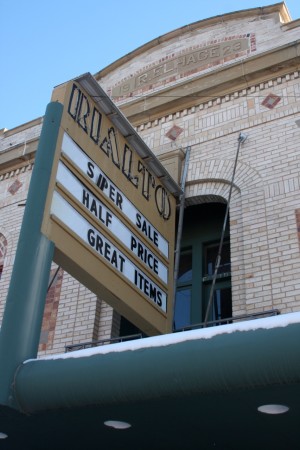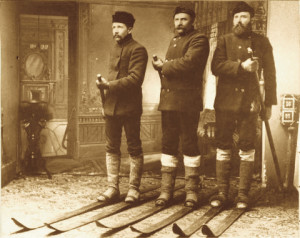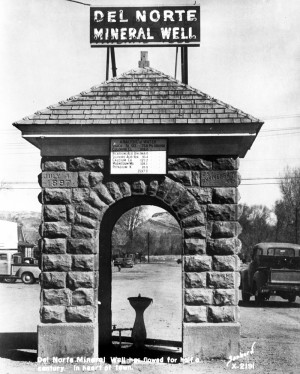By Mike Rosso
Florence, Colorado, neighboring the Arkansas River south of Cañon City, sometimes gets an undeserved bad rap. Having a federal prison complex on its outskirts, it is sometimes referred to as a “prison town.” It’s far from it. Having visited Florence a number of times over the years, I thought it might be fun to take a closer look at this small city with a rich history and dynamic future.
My first visit was city hall, and a meeting with newly elected mayor Keith Ore and City Manager Mike Patterson. Ore was selected as mayor pro-tem after former mayor Charles Giebler suddenly died in January 2013. Ore was then elected to serve a full term in November. Like many small cities in Colorado that once had a mining or manufacturing base, Florence has been challenged with a changing economy. There are no big box stores in the community, and the closest U.S. highway is several miles north of town. Even the Arkansas River, a tourist draw in towns like Salida and Buena Vista, is too far from downtown to have any appreciable effect on visitor numbers. In fact, Florence does not consider itself a tourist town, according to Chamber Director Barbara Folger. But Florence does have one very big thing going for it: antiques. In fact, Florence boasts the highest number of antique stores per capita in Colorado – a total of 18.

Hopes ran high in 1991, during the groundbreaking of the Supermax ADX federal prison, that it might become the catalyst for economic growth for the community, said Folger, but most of the jobs were taken by commuters from out of town who don’t necessarily shop or even buy gas in the town. The Federal Correctional Complex of three prisons did bring short-term growth due to construction jobs, but that ended after its completion.
Florence originated at the former townsite of Labran in 1870 as a railroad depot for trains serving the neighboring mining towns of Rockvale, Williamsburg and Coal Creek. When oil was discovered in the area in 1881, the town literally boomed. It was incorporated in 1887. At one time, Florence produced all the refined oil for “illuminating purposes” in Montana, Utah, Wyoming, New Mexico and Arizona, according to a book published by the Florence Chamber in 1906, Florence and its Environs. Today there are still six oil wells operating within town limits; Florence is said to have the second oldest continuously producing oilfield in the U.S., second only to Erie, Pennsylvania, and the oldest west of the Mississippi, according to Roberta Miller, director of the Price Pioneer Museum. Photos taken of Florence in the early days show oil derricks operating right downtown, next to homes and businesses.
Reduction and refinement of ores from Cripple Creek led to the creation of several mills and smelting plants in the area. Another economic driver, which continues to this day, is the production of cement. Six miles east of Florence is the former company town of Portland, built by the Portland Cement Company, which employed as many as 200 men at its height. Today it is home of Holcim Portland Plant, which continues to produce concrete and provide jobs. During the 30s and 40s, the city saw the closing of coal mines and scaling back of oil production, and many residents had to commute to jobs in Pueblo at C.F. & I. and the Army Depot. Others drove to the Air Force Academy and Fort Carson in Colorado Springs for work. Some were able to find jobs closer to home at Ideal Cement and Estes Model Rockets near Penrose.
Fast-forward to today and a personal tour of several downtown Florence businesses with the new mayor. Keith worked at Denver Water for 35 years before meeting his wife Elsie. They were living in Franktown, east of Castle Rock, raising quarter horses when they discovered Florence on a trip to Santa Fe. As dabblers in antiques, they decided to make a big change and moved to Florence, where they started Heartland Antiques and Gifts on West Main Street. By the time they got there, others had discovered the low rents and historic brick buildings in the old downtown. Florence was quickly finding its niche.
Keith and I ambled about town, visiting other antique stores, several art galleries and restaurants, a floral shop, a bakery, even a downtown bowling alley. Everyone knows him and were glad to talk about the town and how they ended up there. The antique stores are the biggest draw and each boasts its own specialty, such as stained glass or antique lamps. Antique buffs and dealers alike make the trip from Denver, Colorado Springs and Pueblo to poke around the musty-smelling shops in search of old treasures. Florence is also on the map with antique buyers from Texas, Oklahoma and other parts of the West. I also got to meet Peg Peltingrud, who moved to Florence when she was 13 along with ten brothers and sisters. In 1996 she started one of the first antique stores in town, The Mezzanine, and then The Fox Den of Antiquity in 1999. Peg was first bitten by the antique bug at the age of 12. She was attending an auction with her mother, who needed to run an errand. In her absence, Peg bid on and purchased a marble-top dresser for twenty five cents. She recalled a time in Florence in the 1970s and 80s when there were many vacancies downtown but that has all changed with the advent of the antique shops. She has also noted a trend where her generation, including many of her former schoolmates, are migrating back to Florence. Low housing costs, the small-town life and a warmer climate are all contributing factors to this trend.

Peg is also on the board of the Florence Arts Council, which will host the grand opening on Jan. 18 of the Bell Tower Cultural Center, a former Baptist church that was donated to the Council when the congregation grew too small. The Center offers studio space for artists, art and music classes, a performance venue and meeting space in the century-old brick church. The Center is also the home of the Florence Chamber of Commerce. The Arts Council was formed to foster awareness and interest in the arts among Florence residents of all ages and to support and encourage the growth of the arts in the community. Among the classes offered in January alone are stained glass, Norwegian Rosemaling, silk painting, yoga and pastel drawing.
Another member of the Florence community I met was Roberta Miller, director since 2007 of the Price Pioneer Museum on East Front Street. The museum is a two-story stone building which originally served as the Eagles Lodge. It was founded as the Florence Pioneer Museum in 1964 by two members of the Pioneer Day board, Charles Price and Darrell Lindsey, who worked tirelessly to collect funds to repair and remodel the building, which is listed on the National Register of Historic Places. Although the museum is closed during the winter, Roberta agreed to meet me there and gave me a tour of the building which includes artifacts from the region, including mining and industrial displays. She explained how one of the city founders, Senator James A. McCandless, decided to name the town after his youngest daughter. McCandless was a member of the Colorado state legislature in the second and third assemblies and a senator in the sixth and seventh assemblies. He was the first to raise alfalfa in Colorado and bored the first oil well in the Florence district.
Roberta is currently at work on an 8-by-8 foot composite map of the region’s coal fields, which when finished, will have a blue light to represent all 185 coal mines of the region. She also revealed an incredible map she discovered after taking helm of the museum. Created in 1913, the stiff old cardboard map was designed by a few former Florence city fathers who decided that it would be beneficial to secede from Fremont County (taking all of the oil and coal reserves with them) and form a new county, Sunshine County. Their efforts were obviously a bust but will sure make an interesting article for a future issue of Colorado Central. The museum is also working on a grant to put plaques on 50 historic buildings throughout the city to facilitate walking tours in conjunction with their annual September Historic Home Tour. They are open from mid-May through Oct. 5, 12-4 p.m., Tuesday through Saturday.
The Rialto Theater
We met for coffee with Suzanne Phipps, project director for the Rialto Theater, a historic theater on West Main built as an opera house in 1923 by Richard Elhage. It has been undergoing restoration since 1992. The old theater, named after the financial and commercial center of Venice, Italy, once seated nearly 900. It eventually served as a cinema, operating until the 1960s when it closed its doors.

In 1992, a group of area residents formed the Florence Architectural and Cultural Traditions (FACT) with the intention of restoring the condemned theater. Under the direction of Leopold St. Paul, an expert in art restoration and the former head of a Cañon City museum, they formed a 501(c)3 and began raising funds and grants to assist with their efforts. The roof had collapsed and major beams were sagging. There had also been water damage to the walls. Over the next 12 years, volunteers spent 40,000 plus hours gutting and repairing the building. In 2000, St. Paul died, and the project halted for nearly four years. FACT then contacted Phipps, who had a background in fundraising and community projects. She began to schedule fundraising events for the theater and managed to get not one, but two classic cars donated for the cause: a 1957 Corvette and a 1972 Ford Mustang, which combined raised $106,000 towards the effort. By 2007, more than $900,000 had been raised and used in the restoration efforts, which included retrofitting steel-helical piers underneath the stage requiring the removal of over 127 tons of dirt and rubble as well as a new sewer line.
A tour of the massive building gives a sense of its former glory with its wraparound balcony and 50-foot, five-story fly tower. Evidence of the art-nouveau murals can still be found on some of the walls and ceilings. Restoration of the intricate woodwork and plastering on the interior along with the addition of modern bathrooms brought the theater closer to the goal of reopening. They aren’t quite there yet, says Phipps, despite all the work, including sprinklers and fire code regulations; she says that new regulations at the federal level keep raising thebar for the theater. Meanwhile, Phipps continues her seven-day-a-week fundraising efforts, including an ongoing yard sale inside the building every weekend. If the Rialto finally reaches its goal and reopens, it’s hoped the nearly 500-seat theater will serve the entire area, providing performing arts attractions such as theater, music concerts, opera, dance and more.
FLORENCE SPECIAL EVENTS:
Pioneer Days, starts the third Saturday in September.
Paint the Town, Plein Air Festival, October.
Links of interest:
www.pricepioneermuseum.org
www.FlorenceColoradoChamber.com
www.florencecolorado.org





Does the print version contain the same content as the online version?
The print version has considerably more content than the online version. We post sample content on the website monthly and put full content from the print version online after a delay of several months. We also offer an electronic version of the magazine (PDF) for $20 per year. Subscriptions can be ordered at http://cozine.com/subscriptions/
FYI, the two giant companies after the merger would be called as LafargeHolcim, and will be based in Switzerland, where Holcim’s headquarters are located.